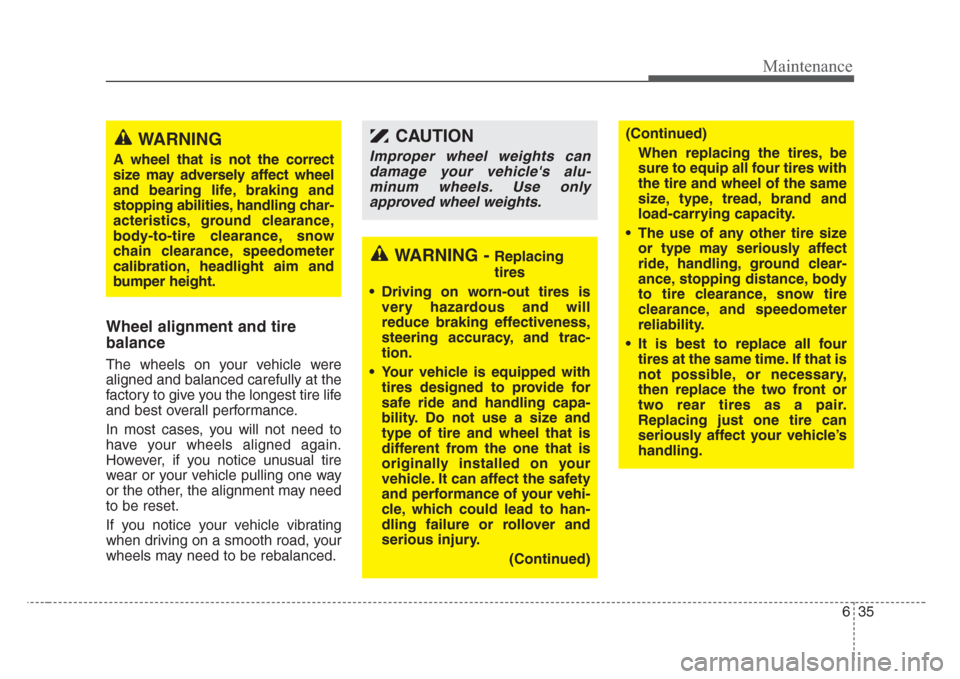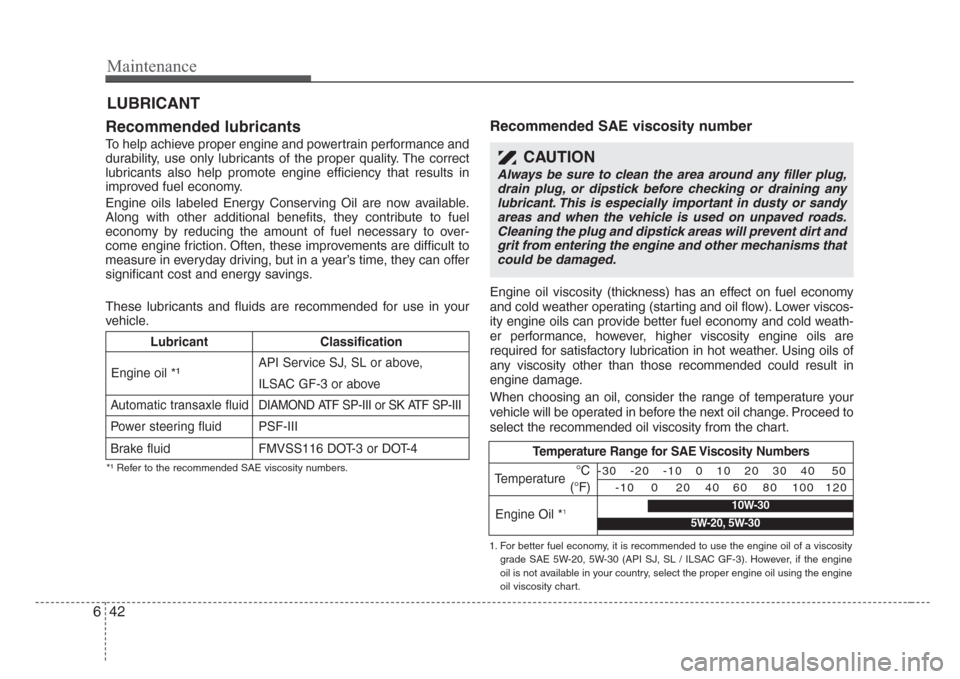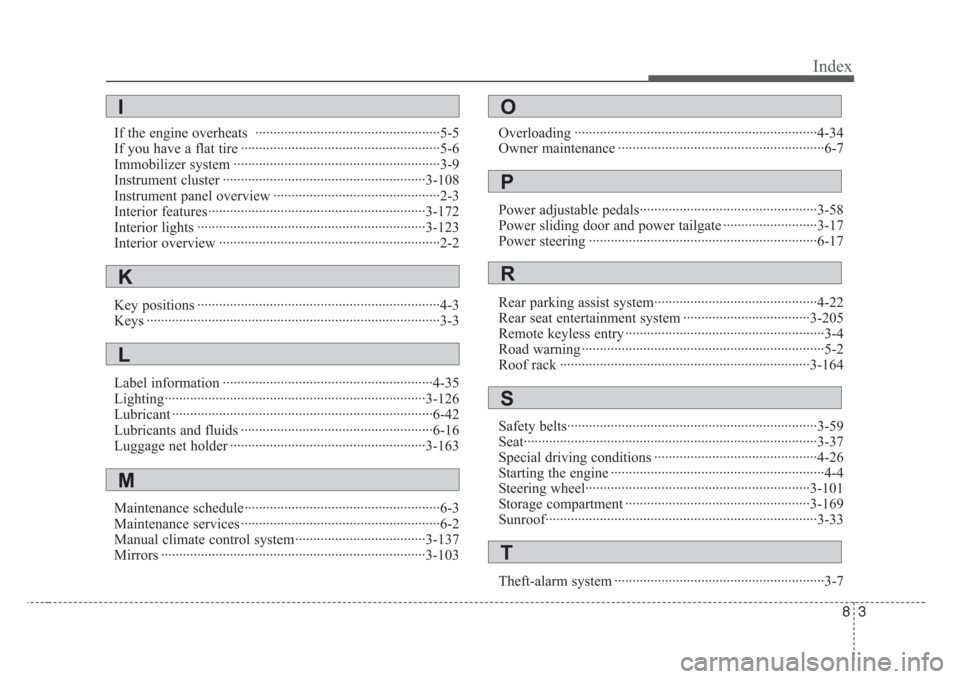Page 320 of 339

635
Maintenance
Wheel alignment and tire
balance
The wheels on your vehicle were
aligned and balanced carefully at the
factory to give you the longest tire life
and best overall performance.
In most cases, you will not need to
have your wheels aligned again.
However, if you notice unusual tire
wear or your vehicle pulling one way
or the other, the alignment may need
to be reset.
If you notice your vehicle vibrating
when driving on a smooth road, your
wheels may need to be rebalanced.
WARNING
A wheel that is not the correct
size may adversely affect wheel
and bearing life, braking and
stopping abilities, handling char-
acteristics, ground clearance,
body-to-tire clearance, snow
chain clearance, speedometer
calibration, headlight aim and
bumper height.
WARNING - Replacing
tires
• Driving on worn-out tires is
very hazardous and will
reduce braking effectiveness,
steering accuracy, and trac-
tion.
• Your vehicle is equipped with
tires designed to provide for
safe ride and handling capa-
bility. Do not use a size and
type of tire and wheel that is
different from the one that is
originally installed on your
vehicle. It can affect the safety
and performance of your vehi-
cle, which could lead to han-
dling failure or rollover and
serious injury.
(Continued)
(Continued)
When replacing the tires, be
sure to equip all four tires with
the tire and wheel of the same
size, type, tread, brand and
load-carrying capacity.
• The use of any other tire size
or type may seriously affect
ride, handling, ground clear-
ance, stopping distance, body
to tire clearance, snow tire
clearance, and speedometer
reliability.
• It is best to replace all four
tires at the same time. If that is
not possible, or necessary,
then replace the two front or
two rear tires as a pair.
Replacing just one tire can
seriously affect your vehicle’s
handling.CAUTION
Improper wheel weights can
damage your vehicle's alu-
minum wheels. Use only
approved wheel weights.
Page 327 of 339

Maintenance
42 6
LUBRICANT
Recommended lubricants
To help achieve proper engine and powertrain performance and
durability, use only lubricants of the proper quality. The correct
lubricants also help promote engine efficiency that results in
improved fuel economy.
Engine oils labeled Energy Conserving Oil are now available.
Along with other additional benefits, they contribute to fuel
economy by reducing the amount of fuel necessary to over-
come engine friction. Often, these improvements are difficult to
measure in everyday driving, but in a year’s time, they can offer
significant cost and energy savings.
These lubricants and fluids are recommended for use in your
vehicle.
Recommended SAE viscosity number
Engine oil viscosity (thickness) has an effect on fuel economy
and cold weather operating (starting and oil flow). Lower viscos-
ity engine oils can provide better fuel economy and cold weath-
er performance, however, higher viscosity engine oils are
required for satisfactory lubrication in hot weather. Using oils of
any viscosity other than those recommended could result in
engine damage.
When choosing an oil, consider the range of temperature your
vehicle will be operated in before the next oil change. Proceed to
select the recommended oil viscosity from the chart.
CAUTION
Always be sure to clean the area around any filler plug,
drain plug, or dipstick before checking or draining any
lubricant. This is especially important in dusty or sandy
areas and when the vehicle is used on unpaved roads.
Cleaning the plug and dipstick areas will prevent dirt and
grit from entering the engine and other mechanisms that
could be damaged.
*¹ Refer to the recommended SAE viscosity numbers.
Lubricant Classification
API Service SJ, SL or above,
ILSAC GF-3 or above
Automatic transaxle fluid
DIAMOND ATF SP-III or SK ATF SP-III
Power steering fluid PSF-III
Brake fluid FMVSS116 DOT-3 or DOT-4
Engine oil *¹
Temperature Range for SAE Viscosity Numbers
Temperature
Engine Oil *
1
°C
(°F)-30 -20 -10 0 10 20 30 40 50
-10 0 20 40 60 80 100 120
1. For better fuel economy, it is recommended to use the engine oil of a viscosity
grade SAE 5W-20, 5W-30 (API SJ, SL / ILSAC GF-3). However, if the engine
oil is not available in your country, select the proper engine oil using the engine
oil viscosity chart.
10W-30
5W-20, 5W-30
Page 335 of 339
73
Specifications
Inflation pressure
kPa (psi)
Front Rear
225/70R16 6.5J×16 240 240
235/60R17 6.5J×17 (35) (35)
T135/90R17 4.0T×17420 420
(60) (60)
Full size tire
Compact
spare tireWheel lug nut torque kg•m
(N•m, lb•ft)
9~11
(88~107, 65~79)
TIRES
ItemTire
sizeWheel size
CAPACITIES
Lubricant Volume Classification
5.2l(5.49 US qt.)
Automatic transaxle fluid 10.9 l(11.52 US qt.) DIAMOND ATF SP-III, SK ATF SP-III
Power steering 1.0 l(1.06 US qt.) PSF-III
Coolant 8.6 l(9.09 US qt.) Ethylene glycol base for aluminum radiator
Brake fluid0.7~0.8l
FMVSS116 DOT-3 or DOT-4
(0.7~0.8 US qt.)
Fuel 80 l(21.1 US gal.) -
Engine oil *1
(drain and refill)API Service SJ, SL or above, ILSAC GF-3 or above
(SAE 5W-20)
*1Refer to the recommended SAE viscosity numbers on the page 6-42.
Page 338 of 339

83
Index
If the engine overheats ···················································5-5
If you have a flat tire ·······················································5-6
Immobilizer system ·························································3-9
Instrument cluster ························································3-108
Instrument panel overview ··············································2-3
Interior features····························································3-172
Interior lights ·······························································3-123
Interior overview ·····························································2-2
Key positions ···································································4-3
Keys ·················································································3-3
Label information ··························································4-35
Lighting········································································3-126
Lubricant ········································································6-42
Lubricants and fluids ·····················································6-16
Luggage net holder ······················································3-163
Maintenance schedule······················································6-3
Maintenance services ·······················································6-2
Manual climate control system····································3-137
Mirrors ·········································································3-103Overloading ···································································4-34
Owner maintenance ·························································6-7
Power adjustable pedals·················································3-58
Power sliding door and power tailgate ··························3-17
Power steering ·······························································6-17
Rear parking assist system·············································4-22
Rear seat entertainment system ···································3-205
Remote keyless entry ·······················································3-4
Road warning ···································································5-2
Roof rack ·····································································3-164
Safety belts·····································································3-59
Seat·················································································3-37
Special driving conditions ·············································4-26
Starting the engine ···························································4-4
Steering wheel······························································3-101
Storage compartment ···················································3-169
Sunroof···········································································3-33
Theft-alarm system ··························································3-7
I
K
L
M
O
P
R
S
T